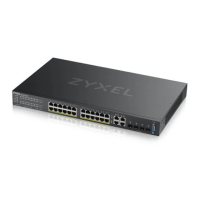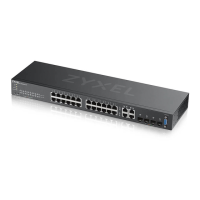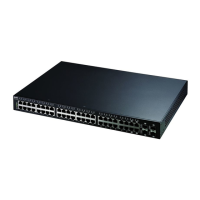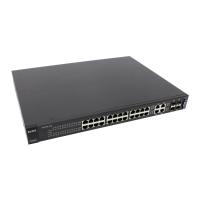Chapter 48 Diagnostic
GS2220 Series User’s Guide
427
The following table describes the labels in this screen.
Table 224 Management > Diagnostic
LABEL DESC RIPTIO N
Ping Test
IPv4 Select this option if you want to ping an IPv4 address, and select vla n to specify the ID
number of the VLAN to which the Switch is to send ping requests. Otherwise, select – to send
ping requests to all VLANs on the Switch.
IPv6 Select this option if you want to ping an IPv6 address. You can also select vla n and specify
the ID number of the VLAN to which the Switch is to send ping requests. Otherwise, select – to
send ping requests to all VLANs on the Switch.
IP Address/Host
Name
Type the IP address or host name of a device that you want to ping in order to test a
connection.
Click Ping to have the Switch ping the IP address.
Count Enter the number of ICMP Echo Request (ping) messages the Switch continuously sends.
Trace Route Test
IPv4 Select this option if you want to trace the route packets take to a device with an IPv4
address, and select vla n to specify the ID number of the VLAN on which the Switch traces
the path. Otherwise, select – to trace the path on any VLAN.
Note: The device to which you want to run a traceroute must belong to the VLAN
you specify here.
IPv6 Select this option if you want to trace the route packets take to a device with an IPv6
address.
IP Address/Host
Name
Enter the IP address or host name of a device to which you want to perform a traceroute.
Click Tra c e Ro ute to have the Switch perform the traceroute function. This determines the
path a packet takes to the specified device.
TTL Enter the Time To Live (TTL) value for the ICMP Echo Request packets. This is to set the
maximum number of the hops (routers) a packet can travel through. Each router along the
path will decrement the TTL value by one and forward the packets. When the TTL value
becomes zero and the destination is not found, the router drops the packets and informs the
sender.
Wait Time Specify how many seconds the Switch waits for a response to a probe before running
another traceroute.
Queries Specify how many times the Switch performs the traceroute function.
Ethernet Port Test Enter a port number and click Po rt Te st to perform an internal loopback test.
Port This is the number of the physical Ethernet port on the Switch.
Cable Diagnostics Enter a port number and click Dia g no se to perform a physical wire-pair test of the Ethernet
connections on the specified ports. The following fields display when you diagnose a port.
Note: This feature is limited to within 100 meters only.
Port This is the number of the physical Ethernet port on the Switch.
Channel An Ethernet cable usually has four pairs of wires. A 10BASE-T or 100BASE-TX port only use and
test two pairs, while a 1000BASE-T port requires all four pairs.
This displays the descriptive name of the wire-pair in the cable.

